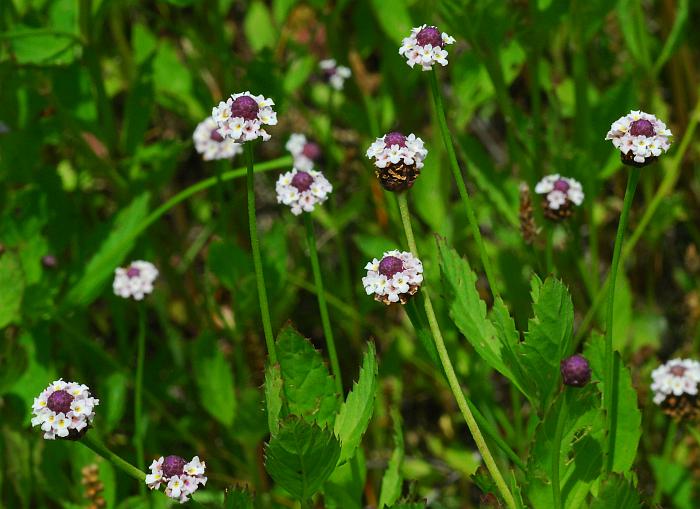Lippia lanceolata Michx.
Northern Fog Fruit

Native
CC = 3
CW = -5
MOC = 83
© SRTurner
Lippia lanceolata Michx.Northern Fog Fruit | |
 |
Native CC = 3 CW = -5 MOC = 83 |
© SRTurner |
|
Family - Verbenaceae Habit - Perennial forb from a sometimes rhizomatous, somewhat woody rootstock. Stem - Prostrate, to 60 cm, few to several from rootstock, often rooting at nodes, sparsely to moderately hairy with sessile dolabriform hairs.
Leaves - Opposite, simple, sessile or nearly so, 1-6 cm long, lanceolate to narrowly elliptic, rhombic, or ovate, mostly broadest at or below the midpoint, tapered to a sharply pointed tip, the margins with 5-11, broad, sharp teeth on each side from below the midpoint to the tip, the surfaces moderately to densely hairy.
Inflorescences - Dense, spherical to oblong, axillary heads, 5-7 mm in diameter, to 3.5 cm long, solitary at the tips of slender, erect, naked stalks to 9 cm long. Bracts 2.5-3.0 mm long, obovate, sometimes with purplish tinged margins.
Florets - Calyces 1.5-1.8 mm long, about as long as the corolla tube, bilobate, keeled, the surface glabrous except for a line of hairs along the keels. Corollas 2.5-3.5 mm long, zygomorphic, somewhat 2-lipped, 4-lobed, white, usually with a yellow or pink central spot at the base of the limb, the limb 2-4 mm in diameter, the lobes slightly irregular or shallowly and broadly notched. Stamens inserted at 2 levels toward the tip of the corolla tube, lacking glandular appendages. Ovary 2-locular (1 of the carpels aborting early in development), rounded at the tip. Style 0.2-0.4 mm long, the minute lobes spreading, but obscured by the confluent stigmatic regions, these appearing as a single capitate stigma.
Fruits - Schizocarps, appearing somewhat flattened longitudinally, circular to broadly obovate in outline, consisting of 2 nutlets, these 0.9-1.2 mm long, more or less hemispheric, usually rounded at the tip and base, the surface finely pebbled or minutely pitted, olive green to yellowish brown. Flowering - May - September. Habitat - Streambanks, pond margins, sloughs, swamps, marshes, crop field margins, ditches, open moist disturbed areas. Origin - Native to the U.S. Lookalikes - Strongly resembles L. nodiflora (which is rare in Missouri). Other info. - This is a very common plant in Missouri, growing in almost any sunny, moist location. It is found throughout most portions of the continental U.S., most commonly in the Midwest and absent in the Northwest. It is distinguished from L. nodiflora by having leaves widest at about the middle and teeth extending from below the middle to the tip. Some authors segregate this and other species of Lippia into their own genus (Phyla), under which classification scheme this plant is named Phyla lanceolata. Photographs taken at Busch Wildlife Area, St. Charles County, MO, 7-31-2009, and at Klondike County Park, St. Charles County, MO, 6-23-2014 (SRTurner). |